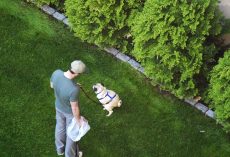They are always there for us, attempting to read our facial expression for signs of love, fear, and acceptance, so it is time for us to read the signs too — in our dogs. If they are ill we need to know it and the following list just might help us — and them!
1. Not Having an Appetite
If you notice any sort of inappetence in your pet, it’s important to seek veterinary attention right away, as this could be a symptom of many dangerous ailments.
2. Breathing Heavily
Panting is normal behavior that shouldn’t surprise any dog owner. But if you notice heavy panting out of nowhere, it could be stress-induced. This stress could be caused by pain your pet is experiencing.
3. Excessive Grooming
If you notice your pet tending to a localized area he’s never noticed before, or has just recently started spending a lot more time there, it could be a sign that he’s hurting.
4. Change in Behavior
Besides shyness and aggression, you might notice that your pup doesn’t want to walk up stairs anymore, avoids jumping and climbing, or doesn’t want to chase after his beloved tennis ball. There are the obvious signs such as limping, but it’s important to also watch out for stiffness or arched backs. Dogs in pain often lay only flat on their sides, rather than curled up in their beds.
5. Acting Shy or Becoming Aggressive
You may notice that your dog is starting to become more and more antisocial. He may stop running to the door to greet everyone and avoids petting. Or you may notice that your little one doesn’t want you picking her up anymore, or cries when you do. If this happens suddenly, it’s reasonable to suspect pain as a probable cause. In some cases, you’ll find your normally overly friendly companion has become aggressive.
6. Having Trouble Resting
If your pooch is in pain, he may struggle with lying or sitting down. If this is the case, you should observe whether he’s having issues staying put or is lying in a funny position. For example, he may try to sit or lie down and then right after get up and move around again.
7. Being Vocal
Even if they’re trying to be tough, dogs in pain tend to be more vocal, but unless this is paired with a specific physical action, it’s not always easy to spot immediately. A hurt dog may express this vocally in a number of ways: whining, whimpering, yelping, growling, snarling, and even howling. If he’s vocalizing more than normal, see what’s up.
8. Eye Changes
If your dog is experiencing eye pain or just pain in general, he may start squinting frequently. Also, his pupils will be smaller. Keep in mind that if he’s experiencing pain in other parts of his body, his pupils will get bigger.
9. Seeking Attention and Withdrawing
Some dogs when they are in pain or sick try to stay away from their owners or may even hide. Others will want attention constantly.
10. Posture Changes
According to Preventive Vet, a dog’s posture also may give away that your poor pup is in pain:
Dogs who are in pain may assume a very rigid, “sawhorse-type” stance, while others may assume the “prayer position” with their front legs on the ground, their butt up in the air, and a stretch throughout their abdomen. It looks like a “play bow”, but it is anything but playful. Some dogs in pain will lie around more, while others will be more “antsy” and have difficulty laying down and getting comfortable. It all depends on the type, location, and severity of the pain. These postural changes can be even more subtle, taking the shape of an arched or sunken back, or even a dropped or tucked tail in a dog who normally has a perky tail.
While we cannot always tell that our best friend is in pain by looking at a pale complexion or having him voice his discomfort, we can see it in other ways.
Remember, when you see Fido constantly licking his paws or having a change in behavior, it does not necessarily mean he is “being silly.” There may be other issues – The poor little or big guy may be sick! If you are unsure, struggling with his behaviors, call the vet!
For more on how to tell if your dog is in pain, visit I Heart Dogs.









